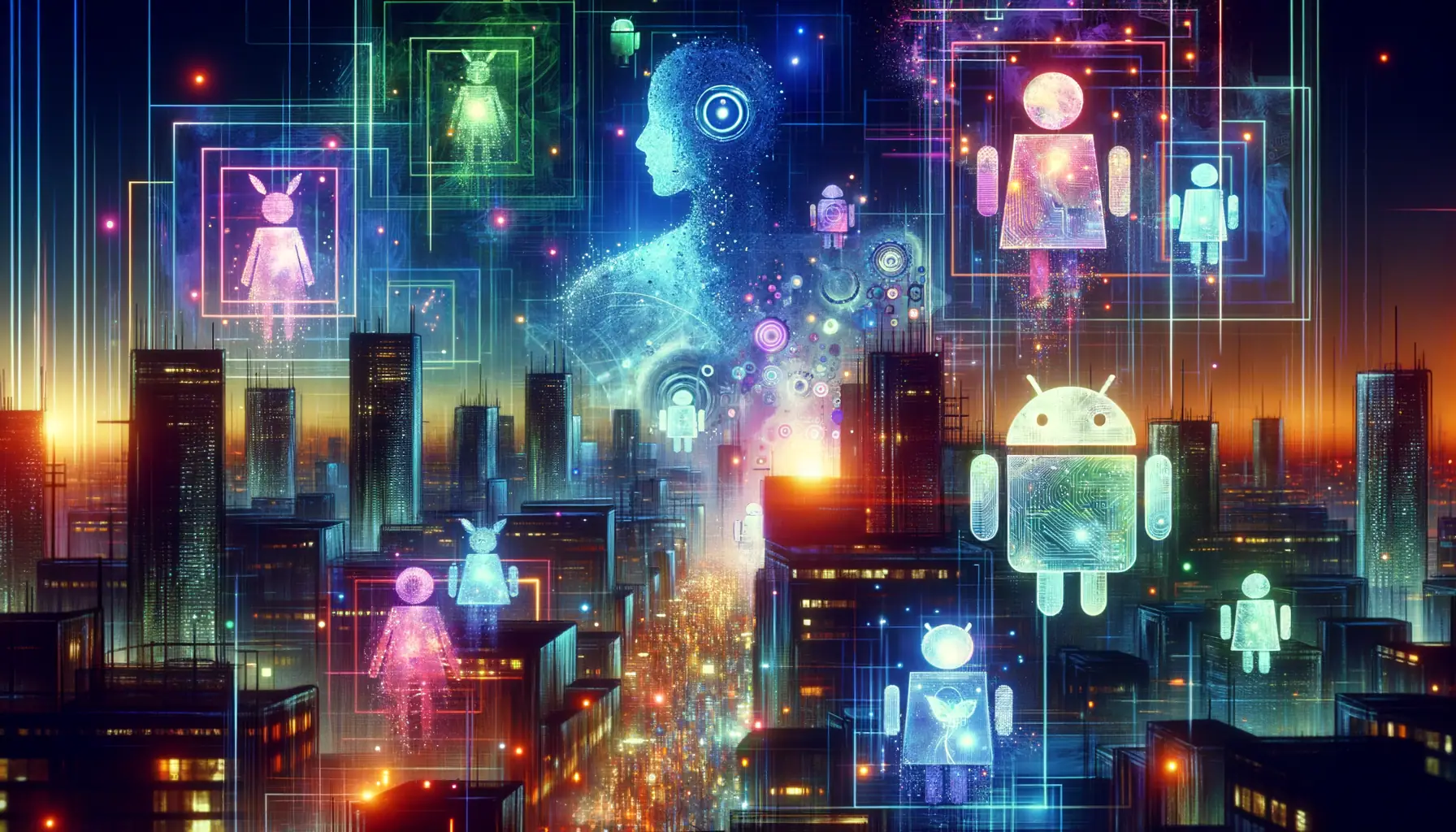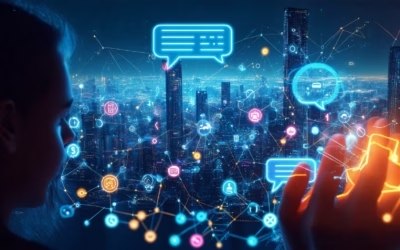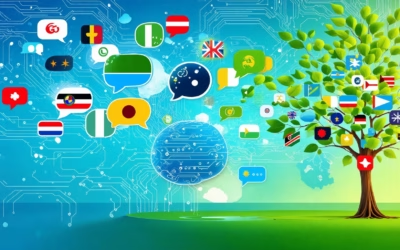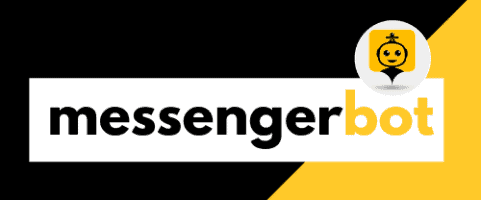Artificial intelligence (AI) has revolutionized the way we interact with technology, and chatbots are at the forefront of this transformation. Powered by advanced AI algorithms and machine learning models, chatbots have evolved from simple rule-based systems to intelligent conversational agents capable of understanding and responding to human language in a natural and contextual manner. As businesses strive to provide seamless customer experiences, the integration of AI in chatbots has become a game-changer, enabling real-time assistance, personalized interactions, and efficient problem-solving. This article delves into the world of AI-powered chatbots, exploring the cutting-edge technologies that drive them, their applications across various industries, and the benefits they offer to both businesses and end-users.
I. How is AI used in chatbots?
Artificial Intelligence (AI) plays a pivotal role in powering modern chatbots, enabling them to engage in natural and intelligent conversations with users. At the core of these AI-driven chatbots lies natural language processing (NLP) technology, which allows the chatbots to understand and interpret human language inputs.
A. AI in chatbots examples
One of the most prominent examples of AI in chatbots is the use of conversational AI assistants like Brain Pod AI’s multilingual AI chat assistant. These AI-powered chatbots can engage in natural, context-aware dialogues, understanding the nuances of human language and providing relevant, personalized responses. They leverage advanced machine learning algorithms, such as natural language processing (NLP), to analyze and comprehend user inputs, extract key entities, and formulate appropriate responses.
Another example of AI in chatbots is the integration of AI-driven chatbot optimization techniques. These techniques enable chatbots to continuously learn and improve their performance by analyzing user interactions and feedback. By leveraging machine learning algorithms, chatbots can adapt their responses, expand their knowledge base, and provide more accurate and relevant information over time.
B. Types of ai in chatbots
AI chatbots can be categorized into different types based on their underlying technology and capabilities:
- Rule-based Chatbots: These chatbots operate based on predefined rules and decision trees, following a structured flow of conversations. They are relatively simple and can handle basic queries effectively.
- Retrieval-based Chatbots: These chatbots use natural language processing techniques to understand user inputs and retrieve the most relevant response from a database of pre-written responses.
- Generative Chatbots: Powered by advanced language models like transformers (e.g., GPT, BERT), these chatbots can generate human-like responses by understanding the context and intent behind user inputs. They are capable of engaging in more natural and dynamic conversations.
- Hybrid Chatbots: Combining the strengths of different approaches, hybrid chatbots leverage both rule-based systems and machine learning models to provide more robust and intelligent interactions.
As AI technology continues to evolve, chatbots are becoming increasingly sophisticated, enabling more natural and engaging conversations across various industries and applications. From customer service to e-commerce, AI-powered chatbots are revolutionizing the way businesses interact with their customers, providing personalized experiences and enhancing overall customer satisfaction.

What is the AI technique for chatbot?
A. Chatbots artificial intelligence
Chatbots rely on several advanced artificial intelligence (AI) techniques to understand and generate human-like responses. The key AI technologies powering modern chatbots include Natural Language Processing (NLP), Machine Learning (ML), and Deep Learning (DL).
NLP is a crucial component that enables chatbots to comprehend and interpret human language, extract relevant entities, and determine the user’s intent behind their query. This is achieved through techniques like Intent Classification, Entity Extraction, and Dialogue Management.
ML and DL algorithms play a vital role in allowing chatbots to learn from data, recognize patterns, and generate contextual responses. These algorithms are used for tasks such as Response Generation, Sentiment Analysis, and Personalization.
Some specific AI techniques employed in chatbots include:
- Intent Classification: Identifying the user’s intent or goal behind their query using algorithms like Logistic Regression, Support Vector Machines, or Deep Neural Networks.
- Entity Extraction: Recognizing and extracting relevant entities (names, dates, locations, etc.) from user inputs using techniques like Named Entity Recognition (NER) and Part-of-Speech (POS) tagging.
- Dialogue Management: Maintaining context and determining appropriate responses based on conversation history, using techniques like Finite State Machines, Seq2Seq models, or Memory Networks.
- Response Generation: Generating natural language responses using techniques like Retrieval-Based Models (selecting from predefined responses), Generative Models (generating new responses using language models like GPT-3), or Hybrid Models (combining retrieval and generation).
- Sentiment Analysis: Analyzing the emotional tone of user inputs to provide more empathetic and contextual responses, using techniques like Lexicon-Based or Deep Learning-Based approaches.
- Personalization: Adapting responses based on user preferences, behavior, and interaction history, using techniques like Collaborative Filtering or Reinforcement Learning.
These AI techniques, combined with access to large language datasets and advancements in computing power, enable chatbots like Messenger Bot to engage in more natural, contextual, and personalized conversations, providing an enhanced user experience.
B. Chatbot ai online
With the rapid advancements in AI and natural language processing, chatbots have become increasingly accessible and can be deployed online for various purposes. Online chatbots leverage the power of cloud computing and AI services, allowing businesses and developers to integrate conversational AI capabilities into their websites and applications without the need for extensive infrastructure or in-house expertise.
Some popular online chatbot platforms and services include:
- Brain Pod AI: A comprehensive generative AI platform offering AI chatbots, image generation, text generation, and more, with a user-friendly interface and advanced language models.
- Anthropic: A leading AI research company focused on developing safe and ethical AI systems, including powerful language models for chatbots and conversational AI.
- Chatfuel: A no-code chatbot builder that enables businesses to create and deploy chatbots on various messaging platforms, including Facebook Messenger, Telegram, and more.
- Pandorabots: A platform for creating and hosting conversational AI agents, with a focus on natural language processing and machine learning.
- IBM Watson Assistant: IBM’s AI-powered chatbot service, which can be integrated into various applications and websites to provide intelligent customer support and engagement.
These online chatbot platforms offer a range of features, including pre-trained language models, custom model training, multi-lingual support, analytics, and integration with various messaging channels and third-party services. By leveraging these online AI chatbot solutions, businesses can enhance customer engagement, automate support processes, and provide personalized experiences without the need for extensive in-house AI expertise or infrastructure.
As AI and natural language processing technologies continue to advance, we can expect online chatbot solutions to become even more sophisticated, offering more human-like conversations, better context understanding, and seamless integration across multiple channels and platforms.
III. What AI algorithm is used in chatbot?
When it comes to the AI algorithms powering chatbots, there is no one-size-fits-all solution. Instead, chatbots employ a variety of advanced AI techniques to facilitate natural language interactions. These include:
- Rule-based systems: These follow predefined patterns and scripted responses, making them well-suited for handling straightforward queries and basic tasks.
- Machine learning models: Algorithms like decision trees, naive Bayes, and support vector machines are used for intent classification and entity extraction, enabling more contextual understanding.
- Deep learning techniques: Cutting-edge approaches like recurrent neural networks (RNNs), long short-term memory (LSTM), and transformers excel at advanced language understanding and generation, allowing for highly natural and contextual conversations.
- Reinforcement learning: These algorithms enable chatbots to learn from interactions and continuously improve their performance through feedback loops, delivering an ever-more personalized experience.
The most sophisticated AI chatbots often utilize hybrid approaches, combining multiple algorithms to leverage their respective strengths. For example, rule-based systems might handle straightforward queries, while machine learning and deep learning models tackle more complex language tasks, with reinforcement learning optimizing the chatbot’s overall performance.
Key factors influencing the selection of AI algorithms include the chatbot’s specific use case, the availability of training data, and the desired level of conversational complexity and personalization.
A. AI chatbots free
While many advanced AI chatbot solutions come at a premium, there are also free options available for those looking to experiment with this technology or build basic conversational experiences. For example, Brain Pod AI offers a free AI chatbot assistant that can be integrated into websites and applications.
Other notable free AI chatbot platforms include:
- Pandorabots: A web service for building and deploying chatbots using AIML (Artificial Intelligence Markup Language).
- Botkit: An open-source developer tool for creating conversational applications and chatbots across various messaging platforms.
- Botlibre: A platform for creating and hosting free AI chatbots, with both web-based and desktop tools available.
While these free options may have limitations in terms of advanced features or scalability, they can serve as valuable learning resources and provide a starting point for exploring the world of AI-powered conversational interfaces.
B. Best ai chatbot
When it comes to the best AI chatbots on the market, there are several standout solutions that have garnered recognition for their advanced capabilities and innovative approaches. Here are some of the top contenders:
- IBM Watson Assistant: Leveraging IBM’s industry-leading natural language processing (NLP) and machine learning technologies, Watson Assistant delivers highly intelligent and contextual conversational experiences across various industries and use cases.
- Dialogflow: A Google-owned platform that provides advanced tools for building conversational interfaces, including support for multiple languages, integration with various messaging platforms, and sophisticated natural language understanding capabilities.
- Amazon Lex: Part of the Amazon Web Services (AWS) suite, Lex is a service for building conversational interfaces into any application using advanced deep learning functionalities for speech recognition, natural language understanding, and dialogue management.
- Microsoft Bot Framework: Microsoft’s comprehensive platform for creating intelligent chatbots and virtual assistants, featuring advanced NLP capabilities, seamless integration with popular messaging channels, and support for multiple programming languages.
- Messenger Bot: A powerful automation platform that utilizes AI to manage and optimize interactions across various channels, including social media platforms and websites. Messenger Bot offers advanced features such as automated responses, workflow automation, lead generation, multilingual support, and e-commerce tools.
It’s important to note that the “best” AI chatbot solution will ultimately depend on the specific requirements and use case of a business or organization. Factors such as industry, target audience, desired features, and integration needs should all be carefully considered when evaluating and selecting an AI chatbot platform.
What are the benefits of AI chatbots?
AI chatbots offer numerous advantages for businesses and customers, revolutionizing the way we interact and engage. By leveraging advanced natural language processing and machine learning capabilities, chatbots provide instant, 24/7 support, addressing inquiries promptly without delays or time constraints. This real-time assistance enhances customer satisfaction and loyalty, fostering strong relationships and brand affinity.
Moreover, AI chatbots deliver significant cost savings by reducing operational expenses associated with human customer service representatives. This cost-effective solution allows businesses to allocate resources more efficiently while maintaining exceptional service quality. By leveraging machine learning and natural language processing, chatbots can analyze customer data and tailor their responses to individual preferences and needs, creating a personalized experience that resonates with each customer.
Additionally, AI chatbots offer scalability and consistency, handling high volumes of simultaneous conversations without compromising quality or uniformity. This ensures a seamless and efficient customer experience, regardless of the number of interactions occurring simultaneously. Furthermore, chatbots gather valuable customer data during interactions, enabling businesses to gain insights into customer behavior, preferences, and pain points. These insights can inform future product and service improvements, driving innovation and enhancing overall customer satisfaction.
Breaking down language barriers, advanced chatbots can converse in multiple languages, providing seamless communication with customers worldwide. This multilingual support opens doors to global markets, facilitating cross-cultural engagement and fostering a truly international presence. By offering 24/7 assistance, personalized recommendations, and streamlined self-service options, chatbots like Brain Pod AI can enhance customer engagement and drive higher conversion rates for businesses.
A. Chat bot examples
Embracing AI chatbots opens a world of possibilities for businesses to enhance their customer experience. From industry leaders like Apple‘s Siri and Amazon‘s Alexa to innovative solutions like Brain Pod AI and Drift, the market is brimming with cutting-edge chatbot examples that demonstrate the transformative power of conversational AI.
Retail giants like Walmart and Target have embraced chatbots to streamline customer service, offering personalized product recommendations and assisting with order tracking. In the banking sector, Bank of America‘s virtual assistant, Erica, and Capital One‘s Eno empower customers to manage their finances effortlessly.
The healthcare industry has also witnessed a surge in chatbot adoption, with platforms like Ada Health and Buoy Health providing symptom assessments and medical guidance. Furthermore, Everyday Robot from Google’s X is revolutionizing customer service with its advanced natural language processing capabilities.
These examples showcase the diverse applications of AI chatbots, highlighting their potential to transform industries and redefine customer experiences across sectors.
B. Artificial intelligence like chatgpt
While traditional chatbots have made significant strides, the advent of advanced language models like ChatGPT from OpenAI has ushered in a new era of conversational AI. With its remarkable ability to understand and generate human-like responses, ChatGPT has captivated users worldwide, sparking discussions about the future of artificial intelligence.
Similar to ChatGPT, platforms like Brain Pod AI are pushing the boundaries of what’s possible with AI chatbots. Brain Pod AI offers a suite of advanced AI solutions, including a multilingual AI chat assistant that can converse fluently in over 100 languages, making it an invaluable tool for businesses seeking to expand their global reach.
Furthermore, Anthropic‘s Constitutional AI and Google‘s Bard are also making waves in the AI chatbot space, offering unique capabilities and approaches to conversational AI. These cutting-edge platforms are not only revolutionizing customer service but also opening up new possibilities in fields like education, creative writing, and research.
As the field of AI continues to evolve, we can expect to see even more innovative solutions like ChatGPT emerge, pushing the boundaries of what’s possible with conversational AI and redefining how we interact with technology.

V. What AI model is used in chatbots?
The AI models employed in chatbots vary depending on the specific application and desired capabilities. However, some of the most widely used AI models for chatbots include natural language processing (NLP) models and machine learning algorithms.
One of the most prominent NLP models used in chatbots is recurrent neural networks (RNNs), particularly long short-term memory (LSTM) and gated recurrent units (GRUs). These models are adept at handling sequential data, making them well-suited for tasks like conversational AI and language understanding. Additionally, transformer-based models like BERT and GPT have gained significant traction in the chatbot space due to their impressive language understanding and generation capabilities.
Machine learning algorithms such as decision trees, support vector machines, and random forests are also commonly used in chatbots for tasks like intent classification and entity recognition. These algorithms help the chatbot understand the user’s intent and extract relevant information from the input.
Furthermore, retrieval-based models and pattern matching techniques are employed for handling simple queries and question-answering tasks. Generative adversarial networks (GANs) and reinforcement learning are also emerging as promising techniques for improving the quality and coherence of chatbot responses.
Leading chatbot platforms like DialogFlow, Amazon Lex, and IBM Watson integrate these AI models, providing customizable solutions for various industries and use cases. As research in AI continues to advance, we can expect to see even more sophisticated models and techniques being employed in chatbots, enabling more human-like and contextual conversational experiences.
A. Chatbots best
When it comes to the best chatbots, there are several leading platforms and solutions that stand out. Messenger Bot, a sophisticated automation platform, utilizes advanced AI and natural language processing to provide intelligent and engaging conversational experiences across various channels, including social media, websites, and messaging apps.
Another prominent player in the chatbot space is Brain Pod AI, a cutting-edge AI platform that offers a suite of generative AI tools, including a powerful multilingual AI chat assistant capable of handling conversations in multiple languages. Brain Pod AI’s chatbot leverages state-of-the-art language models and machine learning algorithms to provide natural and contextual responses, making it a top choice for businesses seeking a robust and scalable chatbot solution.
Other notable contenders in the best chatbot category include Chatfuel, a user-friendly platform for building and deploying chatbots on various messaging channels, and Pandorabots, known for its advanced natural language processing capabilities and customizable chatbot solutions.
B. Chatbots in healthcare
The healthcare industry has witnessed a significant adoption of chatbots, as they offer numerous benefits in streamlining patient interactions, providing medical information, and supporting healthcare professionals. Some of the notable examples of chatbots in healthcare include:
1. Babylon Health: This AI-powered chatbot, available as a mobile app, provides virtual consultations with healthcare professionals, symptom checking, and personalized health insights.
2. Ada: Developed by a team of medical professionals and AI experts, Ada is a symptom assessment chatbot that helps users understand their health concerns and provides guidance on seeking appropriate medical care.
3. Youper: Designed to support mental health and emotional well-being, Youper is an AI-powered chatbot that offers personalized coaching, cognitive-behavioral techniques, and mindfulness exercises.
4. Buoy Health: This chatbot leverages AI and machine learning to provide personalized health assessments, triage recommendations, and connect users with appropriate healthcare resources.
5. HealthTap: HealthTap’s AI-powered chatbot allows users to ask health-related questions and receive personalized answers from a network of medical professionals.
These chatbots not only improve access to healthcare information and services but also help alleviate the burden on healthcare professionals by handling routine queries and providing initial triage. As AI technology continues to advance, we can expect to see even more sophisticated and specialized chatbots emerging in the healthcare sector, further enhancing patient care and support.
VI. Is chatbot true AI?
No, chatbots are not considered true artificial intelligence (AI). Chatbots are based on pre-programmed rules, decision trees, and pattern matching algorithms, lacking the ability to truly understand context or learn from interactions. True AI systems, on the other hand, leverage advanced techniques like natural language processing, machine learning, and neural networks to comprehend and generate human-like responses.
While chatbots can provide scripted responses to specific queries, they cannot engage in open-ended conversations or adapt to new situations without explicit programming. Conversational AI, powered by deep learning models trained on vast datasets, can understand intent, maintain context, and generate dynamic responses, exhibiting a level of cognition closer to human intelligence.
Additionally, chatbots are typically narrow in scope, designed for specific tasks or domains, whereas AI systems can be more general and tackle a wider range of problems. As AI technology continues to advance, the line between chatbots and conversational AI may blur, but currently, most experts agree that traditional chatbots do not qualify as true AI.
A. AI chatbots chatgpt
While traditional chatbots may not be considered true AI, advanced conversational AI models like ChatGPT from OpenAI are pushing the boundaries of what is possible with AI. ChatGPT is a large language model trained on vast amounts of data, enabling it to engage in human-like dialogue, answer follow-up questions, and even tackle creative tasks like writing and coding.
Unlike rule-based chatbots, ChatGPT leverages deep learning techniques to understand context, generate relevant responses, and even exhibit a level of reasoning and knowledge synthesis. It can engage in open-ended conversations, provide detailed explanations, and adapt to new topics, making it a powerful example of conversational AI.
While ChatGPT is not sentient or truly self-aware, it demonstrates the remarkable capabilities of modern AI models, blurring the line between traditional chatbots and AI systems. As the technology continues to evolve, we may see even more advanced conversational AI assistants that can rival human intelligence in certain domains.
B. AI chatbots without filter
As AI chatbots become more advanced and capable of engaging in open-ended conversations, there is a growing demand for AI chatbots without filters or restrictions. These unrestricted chatbots are designed to provide unfiltered responses, without the limitations imposed by traditional chatbots or conversational AI models.
While unrestricted chatbots can offer a more authentic and uncensored conversational experience, they also raise concerns about the potential for generating harmful, biased, or inappropriate content. These chatbots may lack the ethical and safety filters implemented in more controlled AI models, making it essential for users to exercise caution and critical thinking when engaging with them.
Companies like Brain Pod AI are exploring the development of whitelabel AI solutions that can be customized and tailored to specific use cases, including unrestricted chatbots for research or entertainment purposes. However, it’s crucial that these systems are developed and deployed responsibly, with appropriate safeguards and transparency about their capabilities and limitations.
VII. Roleplay AI chat bot
Roleplaying with an AI chat bot like Brain Pod AI’s multilingual AI chat assistant can be an engaging and thought-provoking experience. These advanced conversational AI models are trained on vast datasets, allowing them to engage in dynamic and context-aware dialogues on a wide range of topics. By assuming different personas or scenarios, users can explore the AI’s capabilities and witness its ability to generate coherent and contextually relevant responses.
One popular use case for roleplay with AI chat bots is creative writing and storytelling. Users can prompt the AI to take on the role of a specific character or set the scene for an imaginative narrative. The AI will then generate dialogue and descriptions that align with the given context, enabling collaborative storytelling and worldbuilding. This approach can be particularly useful for writers seeking inspiration or new perspectives on their creative projects.
Roleplaying with an AI chat bot can also be a valuable educational tool. Instructors or learners can simulate real-world scenarios, such as job interviews, customer service interactions, or medical consultations, allowing participants to practice communication skills and decision-making in a safe, low-stakes environment. The AI’s ability to provide dynamic responses based on the user’s inputs creates a more immersive and realistic experience compared to traditional scripted roleplay exercises.
Additionally, roleplaying with an AI chat bot can be a form of entertainment and social connection. Users can engage in lighthearted or whimsical scenarios, exploring different personas and conversational dynamics. This can foster creativity, curiosity, and even empathy as users interact with the AI from different perspectives.
A. Chat ai without filters
While many AI chat bots have filters in place to ensure appropriate and family-friendly responses, some platforms, like Brain Pod AI, offer unfiltered chat experiences for those seeking more open-ended and unconstrained conversations. These “without filters” chat bots can engage in discussions on any topic, including potentially sensitive or controversial subjects, without the limitations imposed by content filters.
It’s important to note that unfiltered chat bots may generate responses that some users find offensive or inappropriate. Discretion is advised when engaging with these AI models, as they may produce explicit or harmful content. However, for users interested in exploring the full range of the AI’s knowledge and capabilities, an unfiltered chat experience can provide valuable insights and foster thought-provoking discussions.
B. AI bot like chat gpt
ChatGPT, developed by Anthropic, has garnered significant attention for its advanced language generation capabilities and its ability to engage in human-like conversations across a wide range of topics. While ChatGPT is a powerful and versatile AI chat bot, it is not the only option available in the market. Several other AI chat bot platforms, such as Brain Pod AI’s multilingual AI chat assistant, offer similar or even more advanced features and capabilities.
Like ChatGPT, Brain Pod AI‘s chat bot can engage in open-ended conversations, provide informative responses, and even assist with tasks such as creative writing, coding, and analysis. However, Brain Pod AI’s chat bot stands out with its multilingual capabilities, allowing users to communicate in various languages, making it a valuable tool for global audiences and businesses.
Additionally, Brain Pod AI offers a range of other AI-powered tools, including an AI writer, an AI image generator, and a whitelabel program for businesses to integrate customized AI solutions into their products and services. By exploring alternatives like Brain Pod AI, users can discover chat bots and AI assistants that may better align with their specific needs and preferences.





